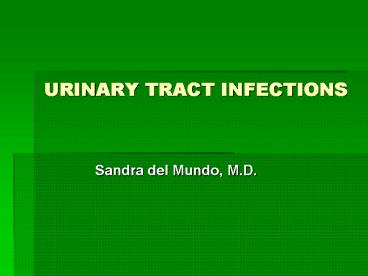URINARY TRACT INFECTIONS - PowerPoint PPT Presentation
1 / 14
Title:
URINARY TRACT INFECTIONS
Description:
Bacteria in perineal area ascends through the urethra, enters the urinary ... Kidney stones. Vesicoureteral reflux. People with indwelling urinary catheters ... – PowerPoint PPT presentation
Number of Views:67
Avg rating:3.0/5.0
Title: URINARY TRACT INFECTIONS
1
URINARY TRACT INFECTIONS
- Sandra del Mundo, M.D.
2
How does a UTI start?
- Ascending infection
- Bacteria in perineal area ascends through the
urethra, enters the urinary bladder and
multiplies - This is the most common route of infection
- Systemic infection
- In a patient with bacteremia, bacteria may be
seeded into the kidneys from the blood
3
What parts of the urinary tract can get infected?
- Urethra - Urethritis
- Urinary bladder Cystitis
- Ureters Ureteritis
- Kidneys - Pyelonephritis
(Most common)
(Most serious)
4
What are the signs and symptoms of UTI?
- Cystitis
- Frequency
- Urgency
- Dysuria painful voiding
- Pain or discomfort in suprapubic or perineal area
or lower back - Cloudy or foul-smelling urine
5
- Acute pyelonephritis
- Fever
- Nausea and vomiting
- More pronounced malaise
- Pain in the back
- () CVA tenderness
6
Who are at higher risk for UTI?
- People with any abnormality of the urinary tract
which interferes with normal flow of urine - Enlarged prostate
- Kidney stones
- Vesicoureteral reflux
- People with indwelling urinary catheters
7
Who are at higher risk for UTI?
- People with compromised immune function
- People with diabetes
- People taking immunosuppressive drugs
- Women in general
- Pregnant women
- Sexually active women
8
What tests do you need to order if you suspect a
UTI?
- If likelihood of simple cystitis is very high
nothing
- If you are not so sure of the diagnosis
- Urinalysis
- Urine dipstick for leukocyte esterase or nitrites
9
How do you treat a UTI? What antibiotic should
you choose?
- Ampicillin
- Amoxicillin
NO!
- Cotrimoxazole
Yes
- Quinolones
Yes
10
How do you treat a UTI? How long should you
treat?
- Single dose of antibiotic
- Three day course
- Seven day course
A three day course provides the best compromise
between effectiveness and cost and side effects
11
When should you refer a patient with UTI to a
nephrologist ?
- Most patients will not need a referral. Only
special cases need to be referred .
- Recurrent UTI More than three UTIs per year
- When UTI symptoms are accompanied by fever or
blood in the urine
12
When should you refer a patient with UTI to a
nephrologist ?
- UTI symptoms in a pregnant woman, or a diabetic
individual
- Any one whose symptoms do not resolve after one
course of antibiotics
- A second UTI episode in an adult male or child of
either sex
- A first UTI episode in an infant
13
Take home messages
- Most cases of acute cystitis will resolve with a
3-day course of quinolones
- Ampicillin and amoxicillin are not recommended
choices for the treatment of UTI because of the
high incidence of resistance
14
Take home messages
- Complicated cases need to be referred































